We all know to build a massive structure, we will first need a solid foundation. I believe possibly that the rocks that were excavated from the Moon’s surface were then melted in massive fusioning caldrons. Possibly streams of lava flow were deliberately poured to create giant slides with walls that brought the lava over the surface of the moon. Possibly a way of laying out what was fusioned. Rocks INSIDE the surface will be harder to burn. Rocks are composed of so many compressed minerals that each have a different boiling point therefore lol only certain minerals inside the rocks composition will burn and the rest will remain in physical form. A rock does not melt homogeneously. When a rock stats to melt, the minerals with the lower melting point melt first, and the minerals with higher melting point take a lot longer. Because of that, rock melting in nature is usually an incomplete, partial phenomena: only some minerals melt, while others remains solid.
Can the Magma formed after burning the rocks be used as a solid foundation for massive structures? Also taking into consideration the gravity in space and how it would interact on any built structure. Just think out of the box. I could have written a book on this subject. I will later on for now lol we learn together. Enjoy these astonishing photos of the Moon’s surface. I am working hard on ways to filter through the haze on the moon’s surface to bring you a real view of the topography and geography of the Moon.












The more I look at these photos, the more I see. Bruce, many thanks to you.
LikeLiked by 2 people
Good Question Bruce on can Magma be used for a solid foundation for structures, Well i guess it could be used after i did some research on this, When Magma cools down it forms what’s called Igneous rock, When the magma solidifies within the earth’s crust, it cools slowly forming coarse textured rocks, such as granite, Gabbro, or Diorite. although there are many other types of rock in the Extrusive and Intrusive Mode of occurrence Compositions … I would imagine this would or could be similar on other planets or moons…… And has the tower block that i live in is built on top of granite rock i guess the answer is yes… 🙂 well they haven’t fell down yet and they have been standing since the 1960s ….. And also found this out, That Intrusive rocks are also called “plutonic” rocks, named after Pluto, the Roman god of the underworld. 🙂 Excellent photos Bruce more to put in my folder 🙂
LikeLiked by 2 people
Plutonic Rocks heheh YA I read about that and thanks for that great feedback man I appreciate it. Yes I also agree it can be solid. Yup Igneous rock. I am blown away not knowing that rocks were composed of several minerals and each of them gave different boiling points. Rocks inside of the ground have a major change in their boiling points. I mean how could anyone find these things out and what you said about the Igneous rock unless they look for themselves. Yup it is true too. I looked it up heheh.
LikeLiked by 1 person